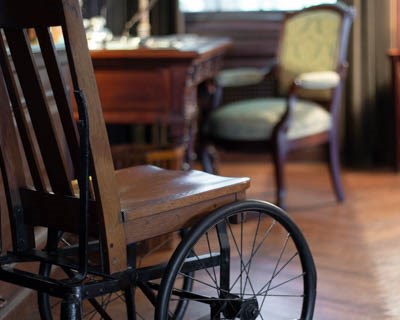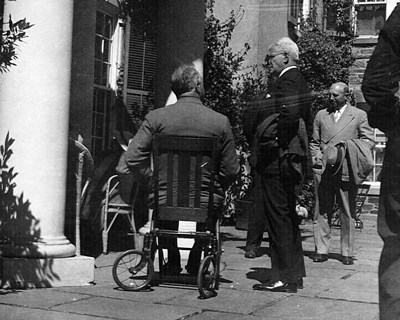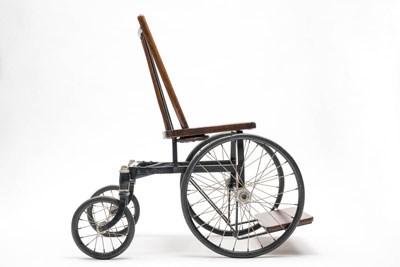
Franklin Roosevelt on the east terrace at Springwood, Hyde Park, 1933. Franklin D. Roosevelt is an icon of disability history. But that was not always the case. Early biographies of the president focused on his personal and political life, and treated his disability as just another obstacle overcome on his path to the White House. Two themes emerged among these early retellings of his experience with polio and paralysis—that FDR "conquered" disability, or that his personal struggle with it made him especially attuned to the nation's suffering during the Great Depression. This remained the predominant disability narrative for nearly four decades. In 1985, a new narrative emerged, portraying FDR as a political figure who hid his paralysis from the American public through acts of deception because, we were told, the public would not knowingly elect a person with a disability. This represented a turning point in how historians and the public understood FDR. No longer omitted or marginalized, disability was understood to be a central and influential experience. However, the deception narrative has remained so entrenched, that a more complete, nuanced understanding of living with disability has been overlooked. In more recent years, the emergence of disability studies has encouraged fresh perspectives. Disability is not only a state of health; it is also a social construction—an interaction between the features of a person’s body and the social or environmental barriers they encounter. The absence of ramps and elevators, lack of access to education and employment, and commonly held prejudice are examples of disabling barriers. This interaction between body and environment is evident in FDR’s story and at Hyde Park—the ramps and handrails at the Big House (Springwood), the swimming pool at Val-Kill, architectural details and landscape features at Top Cottage, and FDR's customized wheelchairs. Ramps at the White House and U.S. Capitol, modified automobiles, architectural innovations at Warm Springs, and even the train car and airplane used by the president, all illustrate how FDR created an environment to mitigate the effects of a world that was not designed for people with disabilities. Many of the barriers and prejudice that FDR and others faced remain prevalent in our world today. But with the passage of legislation like the Americans with Disabilities Act (ADA), the continued efforts of disability rights activists, and greater public awareness, disabling barriers are decreasing. The history of FDR and others who live with disability challenges dominant medical and pathological views. Often misunderstood as helpless or victims of illness and injury, people with disabilities have acted to alter this stigmatization. Their history is everywhere in American history. Disability experiences are present in the history of immigration, labor, war, social reform, politics, education, and popular culture. The life of FDR as a disabled person intersects all of these stories. At the Home of Franklin D. Roosevelt National Historic Site, we are re-thinking the meaning of FDR and disability in American culture. 
Disability Representation at Historic Sites FellowshipThe National Park Service’s Mellon Humanities Postdoctoral Fellowship Program places recent humanities PhDs with National Park Service sites and programs across the agency. The Home of Franklin D. Roosevelt National Historic Site will host one of fifteen Mellon fellowships funded for 2023-2025. This fellowship will support our efforts to reconsider the interpretation of disability history at the park. Disability material culture and accessibility at historic sites will be a focus of the fellowship. The fellowship program is generously supported by Mellon Foundation in partnership with National Park Foundation and American Conservation Experience. 
Disability Things in the Museum CollectionPeople who live with disabilities often rely on things that help them navigate both natural and man-made barriers. These objects can reveal stories of struggle, emotion, exclusion, and human innovation. |
Last updated: May 20, 2025

